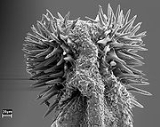
Callosobruchus maculatus
Encyclopedia
Callosobruchus maculatus, the bruchid beetle or the cowpea weevil, is a species
of reddish-brown slightly elongate beetle
. Although weevil-like they are not true weevils (Curculionidae
) and do not have heads prolonged into a long "snout". Wing covers (elytra
) are marked with black and gray and there are two black spots near the middle. They are considered pests. Adults move about readily and can infest seeds in the field, but can also breed continuously in stored dry cowpeas. Larva
e typically develop inside the dried peas. Larvae chew near the surface and leave a thin covering uneaten which appears as a window from which the adults emerge.
Males of Callosobruchus maculatus have spines on their intromittent organs that puncture the female reproductive tract during mating. Females kick their mates during copulation. If females are prevented from kicking the males, copulations last longer and the injuries females sustain are more severe. This interesting behaviour makes them a unique model organism
to study sexual selection
and sexual conflict
. It has been found out that the spines have evolved for other reasons than harming the females, such as serving as an anchor during copulation, and that the harm they cause is a side effect of a male adaptation and is not itself adaptive for either sex.
Species
In biology, a species is one of the basic units of biological classification and a taxonomic rank. A species is often defined as a group of organisms capable of interbreeding and producing fertile offspring. While in many cases this definition is adequate, more precise or differing measures are...
of reddish-brown slightly elongate beetle
Beetle
Coleoptera is an order of insects commonly called beetles. The word "coleoptera" is from the Greek , koleos, "sheath"; and , pteron, "wing", thus "sheathed wing". Coleoptera contains more species than any other order, constituting almost 25% of all known life-forms...
. Although weevil-like they are not true weevils (Curculionidae
Curculionidae
Curculionidae is the family of the "true" weevils . It was formerly recognized in 1998 as the largest of any animal family, with over 40,000 species described worldwide at that time...
) and do not have heads prolonged into a long "snout". Wing covers (elytra
Elytron
An elytron is a modified, hardened forewing of certain insect orders, notably beetles and a few of the true bugs ; in most true bugs, the forewings are instead called hemelytra, as only the basal half is thickened while the apex is membranous...
) are marked with black and gray and there are two black spots near the middle. They are considered pests. Adults move about readily and can infest seeds in the field, but can also breed continuously in stored dry cowpeas. Larva
Larva
A larva is a distinct juvenile form many animals undergo before metamorphosis into adults. Animals with indirect development such as insects, amphibians, or cnidarians typically have a larval phase of their life cycle...
e typically develop inside the dried peas. Larvae chew near the surface and leave a thin covering uneaten which appears as a window from which the adults emerge.
Males of Callosobruchus maculatus have spines on their intromittent organs that puncture the female reproductive tract during mating. Females kick their mates during copulation. If females are prevented from kicking the males, copulations last longer and the injuries females sustain are more severe. This interesting behaviour makes them a unique model organism
Model organism
A model organism is a non-human species that is extensively studied to understand particular biological phenomena, with the expectation that discoveries made in the organism model will provide insight into the workings of other organisms. Model organisms are in vivo models and are widely used to...
to study sexual selection
Sexual selection
Sexual selection, a concept introduced by Charles Darwin in his 1859 book On the Origin of Species, is a significant element of his theory of natural selection...
and sexual conflict
Sexual conflict
Sexual conflict occurs when the two sexes have conflicting optimal fitness strategies concerning reproduction, particularly the mode and frequency of mating, leading to an evolutionary arms race between males and females. The conflict encompasses the actions and behaviors of both sexes to influence...
. It has been found out that the spines have evolved for other reasons than harming the females, such as serving as an anchor during copulation, and that the harm they cause is a side effect of a male adaptation and is not itself adaptive for either sex.

